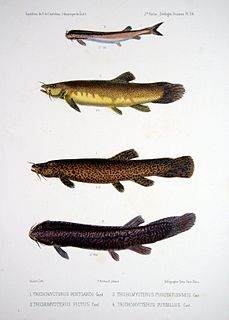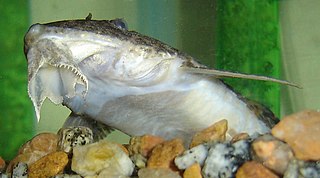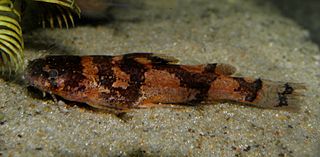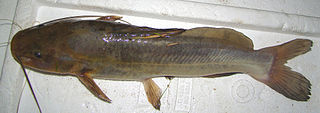
Trichomycteridae is a family of catfishes commonly known as pencil catfishes or parasitic catfishes. This family includes the candiru fish, feared by some people for its alleged habit of entering into the urethra of humans. Another species is the life monsefuano which was important to the Moche culture and still an important part of Peruvian cuisine.

The Doradidae are a family of catfishes also known as thorny catfishes, raphael catfishes or talking catfishes. These fish are native to South America, primarily the Amazon basin and the Guianas.
Listrura is a genus of pencil catfishes native to South America.

Aspidoras is a genus of catfishes of the family Callichthyidae from Brazil.

Rineloricaria is a genus of freshwater tropical catfish belonging to the family Loricariidae. They are commonly called whiptail catfish because of the long filament that grows out of the tip of the caudal fin that is characteristic of the genus. With the exception of R. altipinnis from Panama, they are native to the rivers of northern and central South America. Some species are regularly seen in the aquarium trade.

Trichomycterus is a genus of fish in the family Trichomycteridae, the largest genus of its family with over 170 species currently described. This genus is native to freshwater habitats in Central and South America. These fish are generally small, usually about 5 to 15 cm (2–6 in) in standard length, although the largest, T. rivulatus, can reach more than twice this size. Species differ from one another primarily in body proportions, fin ray counts and colouration. Despite their relatively small size, some, such as T. punctulatus, support fisheries and are important in the local cuisine.
Trichomycterus guaraquessaba is a species of pencil catfish presently only known from Rio Bracinho, a small isolated river in Paraná state, Brazil.

Microglanis is a genus of fish in the family Pseudopimelodidae native to South America. This genus has the widest distribution within its family, with species ranging from the Guianas to Venezuela; western slope of the Andes in Ecuador and Peru to the Río de La Plata basin in Argentina. They occur eastward to the Orinoco and Amazon basins. It is also present in the eastern coastal rivers of Brazil.

Farlowella is a genus of fish in the family Loricariidae native to South America. This genus is broadly distributed in Amazon, Orinoco, Paraná and coastal rivers of the Guyana Shield. It is absent from the Pacific slope of the Andes and from the coastal rivers of the Brazilian Shield. Many of these species are kept in aquarium. This genus has a unique body shape that resembles of a thin stick of wood. The body is slender and elongate, often with a pronounced rostrum and a brownish color with two lateral dark stripes beginning at the tip of the rostrum, passing over the eyes and ending at the tail, which are periodically interrupted on the caudal peduncle.

The Hypoptopomatinae are a subfamily of catfishes of the family Loricariidae, composed of 17 genera and approximately 80 species. This subfamily represents about one-tenth of all loricariid species.

Pimelodus is a genus of fish in the family Pimelodidae native to Central and South America.
Hisonotus is a genus of armored catfishes native to South America. Species of Hisonotus and Curculionichthys are the only representatives of the subfamily Otothyrinae having serrae on the posterior edge of the pectoral fin spine. These species are small fishes, generally found in small fast flowing streams, where they grasp to the branches and leaves of aquatic or subaquatic plants. The species of this genus mostly occur in Atlantic coastal streams of southern Brazil and the Paraguay-Paraná system of southern South America. They are also distributed in the Río de La Plata basin and coastal rivers of southeastern Brazil.
Pareiorhaphis is a genus of catfish in the family Loricariidae native to South America. This genus can be readily distinguished from other neoplecostomines by the unique combination of having fleshy lobes on lateral margins of head ornamented with hypertrophied odontodes on nuptial males, caudal peduncle ovoid in cross section, abdomen usually naked, dorsal fin spinelet ovoid and adipose fin usually present. The color pattern is usually dark brown and mottled with the abdomen white. Most species in to Pareiorhaphis were originally described in Hemipsilichthys. In 1918, Alípio de Miranda-Ribeiro proposed the new genus Pareiorhaphis. Whether Pareiorhaphis is monophyletic or not is currently unknown.
Neoplecostominae is a subfamily of South American catfishes of the family Loricariidae. Species of this subfamily live in high-mountain and swift-flowing river habitats.

Parotocinclus is a genus of fish in the family Loricariidae native to South America. This genus is distributed through almost all hydrographic systems in South America from the Guyana Shield drainages and Amazon Shield tributaries to the coastal drainages of eastern and southeastern Brazil, including the rio São Francisco basin. Most species have the caudal peduncle oval in cross section. It has been found that Characidium species may interact with P. maculicauda. The small Characidium will follow grazing P. maculicauda, which release particulate matter dislodged from the catfish's foraging.
Glaphyropoma is a genus of small pencil catfishes native to Bahia in Brazil.
Ochmacanthus is a genus of pencil catfishes native to South America. These species are distributed in South America. O. alternus and O. orinoco originate from the Rio Negro and Orinoco River basins of Brazil and Venezuela. O. batrachstoma inhabits the Paraguay River basin in Brazil. O. flabelliferus lives in river drainages in Guyana and Venezuela. O. reinhardtii is known from the Amazon River basin in Brazil and drainages in French Guiana.

Rhamdia is a genus of three-barbeled catfishes found in Mexico, Central and South America. These catfishes are nocturnal, opportunistic carnivores, found in a wide range of freshwater habitats. This genus includes a number of troglobitic members, encompassing a number of taxa, including R. enfurnada, R. guasarensis, R. laluchensis, R. laticauda, R. macuspanensis, R. quelen, R. reddelli and R. zongolicensis. In a few of these only some of their populations are troglobitic.

Cavefish or cave fish is a generic term for fresh and brackish water fish adapted to life in caves and other underground habitats. Related terms are subterranean fish, troglomorphic fish, troglobitic fish, stygobitic fish, phreatic fish and hypogean fish.
The Copionodontinae are a subfamily of catfishes of the family Trichomycteridae. It includes two genera, Copionodon and Glaphyropoma.












